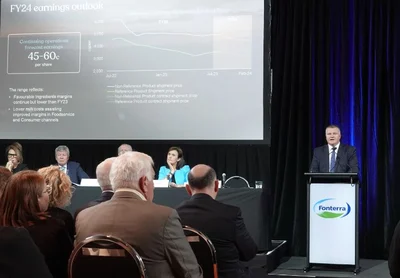Emissions focus a good thing

Fonterra’s ambitious emissions reduction announcement might not make everyone happy – but the focus on the issue is a good thing, a Mid Canterbury dairy expert says.
Fonterra has set its sights on a 30% intensity reduction in on-farm emissions for the co-operative's dairy farmers, announcing the move at its AGM in Methven this week.
The new target comes after a 10-month consultation with the 9000 dairy farmers who are part of Fonterra.
Mid Canterbury Federated Farmers dairy chair Nick Giera said the new targets would affect each farm differently.
Local Mid Canterbury farmers who had access to irrigation water and good soils for growing grass would be less impacted than regions that relied on imported feed.
While he felt no-one would be "happy" with the targets the good thing was the focus on emissions intensity.
"That is a proxy for efficiency - and New Zealand's dairy farmer were one of the most emissions efficient produces in the world."
Giera said if the target was to reduce total emissions, then milk production would fall and the gap in the global market would be filled by less efficient milk from other producers.
Local Dorie dairy farmer and Fonterra Co-operative councillor Mark Cressey said the announcement did not come as a surprise.
He said Fonterra had announced plans to introduce an emissions target 12 months ago and had been talking to farmers all year explaining what competitors were doing.
The 30% was similar to competitor's targets, but would be a challenge.
"Most of it comes down to on-farm efficiencies and new and novel technology."
If a farmer got rid of the poorest performing 10% of the herd they would come close to the on-farm emission target.
Farmers had achieved 2% of the required 7% reduction in on-farm emissions since 2018 through normal efficiency gains - when there wasn't a target.
Now famers would need to make changes a bit faster, he said.
Cressey said the reductions from new technology was the biggest grey area.
"Novel technology has to come in at an affordable price."
Shareholders were told at the meeting in Methven on Thursday that the emissions target was needed to future proof the business as customers - and lenders - were increasingly interested in sustainability and carbon emissions.
Fonterra chief executive Miles Hurrell told shareholders that "sustainability was the top concern for customers overseas" and Fonterra's emissions target would help "future proof the co-operative and your business".
Fonterra's 30% reduction was co-operative-wide and would not be measured on a farm by farm basis. However, every member had a part to play.
Hurrell said every farm would be expected to have an action plan and the plan would look different for each farm.
He promised that the co-operative would work alongside farmers, not against them, to achieve the target.
McBride said the need for an on-farm emissions target did not change with the election - it was driven by Fonterra's key customers.
McBride said a focus on sustainability and emissions was the "commercial reality of doing business" and would "catch up with everyone eventually".
In response to a shareholder question whether the emissions target was based on science or market politics, Hurrell said the target was "driven by what our customers are seeking".
McBride said it was science-based but definitely driven by customers and the future need to source capital.
Achieving the target would require a combination of sharing best farming practices and technology to reduce emissions, he said.
Chair of Fonterra's Co-operative Council, John Stevenson, said there had been an increase in tension as the focus on sustainability had encourage a look "behind the farm gate".
Fonterra had met all but one of the 10 performance measures - the farmgate milk price - in the last year.
Stevenson said there was a drop in shareholder confidence in both Fonterra and the future of the dairy industry. However, some he noted some of the causes of that would be out of Fonterra's scope of influence.
Fonterra expects to reduce emissions by about 22% through improved farm practices, new technology and offsetting emissions with planting.
The remaining 8% would come from no longer needing to account for emissions created by land use change to dairy farms earlier this century, by the time 2030 rolls around.
By Sharon Davis

